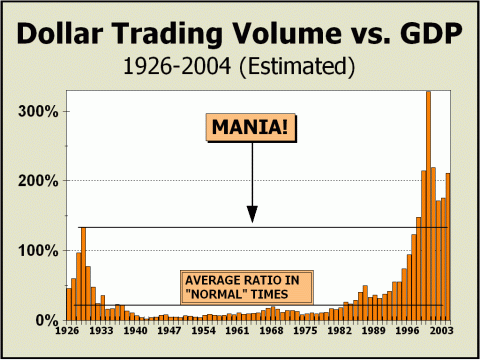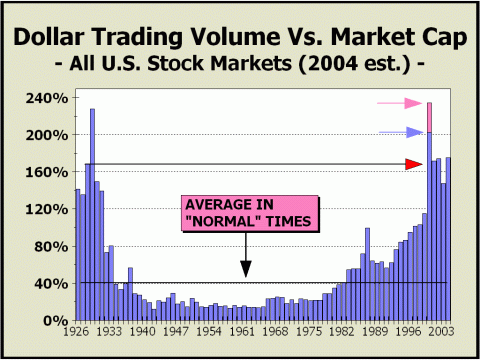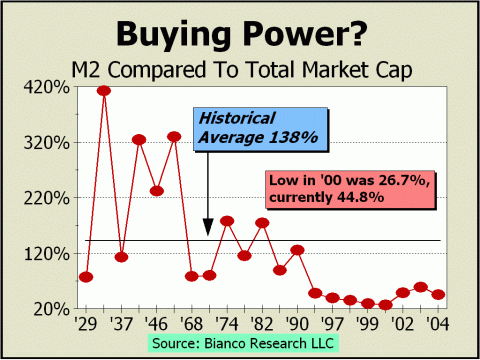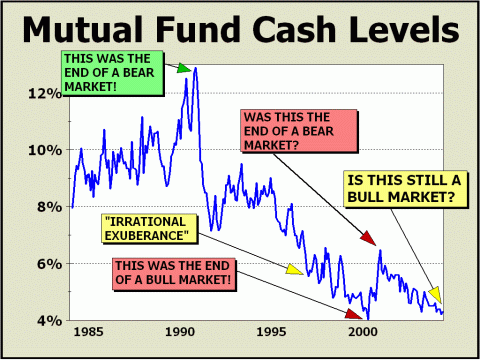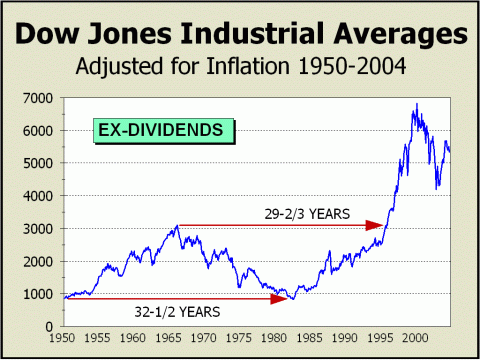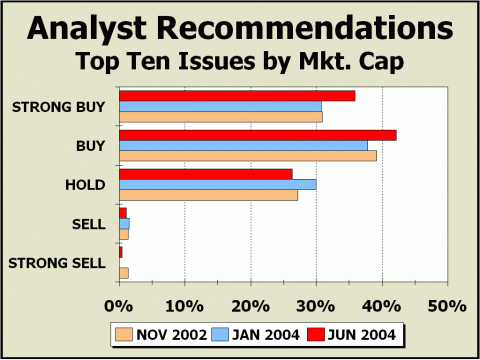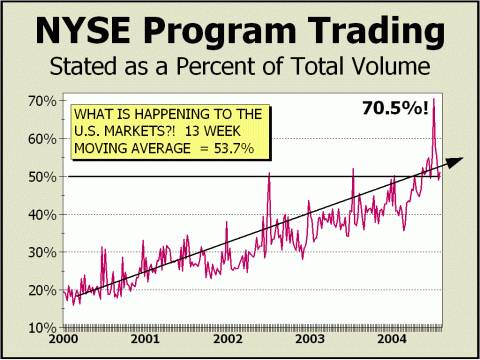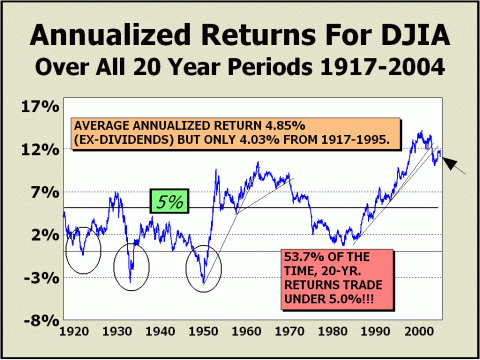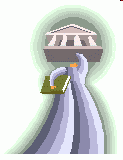
|
- THE GREATEST STOCK MARKET MANIA OF ALL TIME - DATED AUGUST 6, 2004 A SPECIAL REPORT BY ALAN M. NEWMAN, EDITOR LONGBOAT GLOBAL ADVISORS CROSSCURRENTS PICTURES OF A STOCK MARKET MANIA HAS RECEIVED MORE THAN ONE MILLIONTH VISITORS AND OUR ENTIRE WEBSITE HAS HAD WELL OVER 2-1/2 MILLION VISITS SINCE WE COMMENCED PUBLISHING ON JANUARY 15, 1999. IF YOU BELIEVE YOU HAVE FRIENDS WHO MIGHT BE INTERESTED IN VISITING, PLEASE LET THEM KNOW. WE'RE ALWAYS OPEN AND EVERYONE IS WELCOME. |
| Despite the
bulls' best wishes and countless rationales presented for higher prices,
2004 has turned out to be a boring and inconclusive year, confounding bears
as well. Momentum is the strongest force in the markets and a
sideways market can develop a momentum of its own. It is painfully
obvious that prices are waiting for a catalyst to determine the next trend.
In the interim, the arena continues to build upon complacency or apathy,
both of which are typical of sideways markets. When apathy rules,
the outcome tends to be bullish for prices. When complacency rules,
the outcome tends to be bearish for prices. In this report, we will
examine the possibilities to determine if apathy or complacency has the
upper hand and thus, which is likely to determine the next substantial
move in price.
- VELOCITY - Since our last update, average daily volume has fallen by 8.3% for the New York Stock Exchange and 11% for Nasdaq. This has impacted Dollar Trading Volume stats, which nevertheless, still illustrate an ongoing mania. In fact, the only year that clearly surpasses the present year is 2000, when the whole of Nasdaq traded at a stratospheric valuation of more than 250 times earnings. Given the proximity to the levels attained in 1999 and 2001, it must be apparent that current activity borders on dangerous, at the very least, and is already far beyond what passes for irrational exuberance, at worst. However, DTV shows no signs of permanent slippage. Whatever slack is found on the NYSE and Nasdaq is dutifully taken up by the many Exchange Traded Funds that now trade on the American Stock Exchange. We estimate that DTV for the Amex is now well more than triple what it was when the mania peaked and it continues to expand with each new listing of an ETF. Through March 2004, there were 140 ETFs and HOLDRs listed on the Amex. Given the rapidity of new listings and daily fluctuations, we can only estimate valuations at this point. The QQQ trust is unquestionably the most popular stock market issue of all time and trades on the Amex. The Qs typically trade 100 million shares per day at an average price this year of more than $35. This one security alone will likely trade approximately $882 billion this year, more than 3.5 cents of every dollar traded in the U.S. And it's not just institutions. Nasdaq has pointed the Qs directly at the smaller investor and the public. It would be ironic if the fall in volume for Nasdaq was attributable to more activity in the Qs and other ETFs that mirror Nasdaq stock issues. Nevertheless, what you see is what you get. We see transactional velocity still moving at a rather rapid clip. Apathy does not generate this kind of activity but complacency certainly does.
- WHAT IS IMPORTANT (HINT: NOT MONEY) - What's important? Stocks. Perhaps not the only game in town but pretty close to retaining the public interest to the exclusion of much else. We treat "normal" times as those that are not subject to manias, and at those times, DTV has averaged roughly 40% of total U.S. stock market capitalization. As seen below, in 1928, this measurement ran to 169% and then to 228% by the end of 1929. Although the end of year 2000 witnessed our measurement at 203%, well below year end 1929, we have extrapolated that at the March 2000 peak (see pink extension), DTV vs. market cap was as high as year end 1929. Obviously, before the '29 market crash, the measurement was even higher. However, we do not believe we have to make a direct comparison in order to show the extent of the current mania. Indeed, one glance at the sideways arrow from 1928 clearly illustrates that we remain in territory only inhabited by manias. Apathy does not generate this kind of activity but complacency certainly does.
What's important? Money itself is no longer important, compared to stocks. Below, courtesy of Bianco Research, LLC (www.biancoresearch.com), we present a stylized view at the importance of the stock market vis-a-vis the money supply that drives price. The 2000 low for this indicator clearly suggested that optimism had taken the reins and made stock prices far more important than money itself. Although the first leg of the secular bear lessened the role of stocks, M2 compared to total market cap rose to only 59%, still far below any reading since 1990 and a small fraction of the historical average. And now, as prices have corrected to the upside (presumed by many as a new bull market), the indicator has fallen to 44.8%. Apathy does not generate this kind of activity but complacency certainly does.
We see the most glaring impact of the incredible indexing craze in the reported cash levels of mutual funds, many of which are now index funds. By definition, an index fund invests solely in the companies that comprise the index, be they the Standard & Poors 500, the Russell 3000, or the Dow Industrials, which are buyable in the form of the Dow "Diamonds" ETF. Market indexes are representations of the companies in the index or average and indexes and averages hold no cash, thus as indexing grows, the impetus is for funds to hold less cash. As well, in order to compete with a passively managed index fund which holds no cash, active managers now hold less and less cash. Interpreting this chart requires very simple logic. All one need do is read the boxes and make a few inferences. First, the green box points to a multi-year high for mutual fund cash reserves. It marked the end of a bear market and the beginning of a huge bull market. Why? Buying power was plentiful. Our second arrow points to where Fed Chairman Alan Greenspan posed the question of "irrational exuberance." Greenspan had already privately admitted several months earlier that the market was an asset bubble. Clearly, it was a bubble. Third arrow - the chairman's warning fell on deaf ears and mutual funds continued to pare cash, all the way down to 4% in February 2000, the lowest level since December 1972 and the second lowest level ever. Fourth arrow - As the first leg of the bear market took hold, cash rose, but not to any level that previously ever market the end of a bear market. Cash rose to 6.5% and began falling again as prices rose. Fifth arrow - at the current level of 4.3%, cash reserves are once again in territory reserved for very significant market tops. Apathy does not generate this kind of activity but complacency certainly does. Note: In recent years, end of monthly readings under 4.5% have only taken place from December 1999 through March of 2000, in February 20003, and from December 2003 through today.
- THE DAY AFTER TOMORROW - Look at the chart and remember, we're all told to buy for the long term. What is the long term? Twenty years? Thirty years? Suppose you took all the money you would need to live on for a year, including something set aside for a new car and dishwasher, and put it into stocks in 1950. In July of 1982, you could have sold your stocks and lived for a year on the proceeds, including the purchase of the new car and dishwasher. But you wouldn't have had an extra dime to show for the 32-12 years. Suppose you did the same thing in January of 1966. By 1995, your predicament would have been the same. After 29-2/3 years, you'd have a whole lot more money, but everything would have cost a whole lot more. Fast forward to 2000. Stocks hit another inflation adjusted high. Could it be another 30 years until the buying power of the mania is surpassed? Scares the heck out of us. And that's why we wrote the following article a couple of months ago. "The Day After Tomorrow" is in our view, probably the best article we have presented in at least a year. It deserves your attention.... Reprinted from the June 7th issue of Crosscurrents:
A May 28th John Hechinger Wall Street Journal article claimed "Magellan Manager Feels The Heat." In our view, this is one of the most important stories of the year, but is a story likely to be little regarded in the light of the election, Iraq, terrorism, and the economy. Robert Stansky took over the reins at the gigantic Fidelity fund in 1996 and has since under performed the S&P 500, pushing Magellan 71% higher versus an 85% rise in the S&P. Why? First of all, for huge funds like Magellan, there is just far too much money under management to be able to invest in smaller companies with great promise and make the investment worthwhile. For instance, if Stansky went bonkers over a $500 million company with phenomenal prospects, a 5% position in the outstanding capitalization would amount to $25 million, or a mere 1/27th of 1% of Magellan's assets. Just how many companies of this size could the fund ever hope to keep track of on an ongoing basis? Thus, the fund's very size of $68 billion limits its potential. Secondly, as index funds and ETFs have proliferated, stock prices have become more and more inefficient. The Efficient Market Hypothesis has been obliterated by years of indexing. Perhaps there once was a time where one could postulate that all relevant information was factored into share price but no longer. In the "index" world, shares are bought because of their relative size and for no other reason. If the fundamentals do not matter, neither can price! Thus, ALL indexed shares are to some degree, inefficiently priced. John Bogle, the father of indexing and the founder of the Vanguard Index funds recently went on record to replace the religion of EMH with a new religion, CMH, or "Cost Matters Hypothesis." Bogle claims, 'We don’t need the EMH to explain the dire odds that investors face in their quest to beat the stock market. We need only the CMH. Whether markets are efficient or inefficient, investors as a group must fall short of the market return by the amount of the costs they incur.' In other words, cut your costs to the quick and simply forget about everything else, like buying value or timing. Buy high if you like. Of course, the presumption must be you will either never sell or by the time you have to sell, the “long term” will have kicked in and have assured one's money's worth. The trouble with this extremely simplistic line of reasoning is that it does not work! In the same manner that one takes risks by attempting to buy value or to buy when prices are low and sell when they are high, one must necessarily take GREATER risks by using NO intelligence at all to buy ALL stocks at ANY time. In the one case, since intelligence is utilized, mistakes can certainly be made. In the other case, since intelligence is NOT utilized, MORE mistakes MUST certainly be made! And as for the long term kicking in, no guarantees can be made or implied. Our case in point; from the time the Dow peaked in January of 1966, the Dow took 29-2/3 years to surpass that peak adjusted for inflation - a whopper of a mistake. And despite Wall Street's proclivity to focus on absolute gains, in relative terms, they can underwhelm significantly. Adjusted for inflation and ex-dividends, the Industrials actually lost ground from where our chart commences in January 1950 through July 1982, a whopping 32-1/2 years! Stocks are not an investment for all times. Ironically, it was actually CMH, not EMH, that gave indexing the edge to begin with. As in all competitive arenas, only a few can stand out and the vast majority of fund managers are incapable of providing above average performance. After fees, there was never any doubt that an index providing an average return had to outperform under average performance, thus money had to gravitate towards passive management. And the more money that gravitated towards passive management, the more inefficiently stocks were priced and the better EMH seemed to work. An illusion and a paradox. It was a CMH "edge" all along. And now, after a decade-and-a-half of indexing, the market is sufficiently indexed to presume gross inefficiencies proliferate. Excellent evidence of inefficiencies is visible via Price/Earnings ratios, Price/Sales ratios, and Price/Book rations, which have ranged well above historic highs for all of the last several years. We now believe that these inefficiencies, along with the advent of pervasive mechanical factors, may have set the stage for vastly increased odds of a veritable stock market crash. For months, we have railed out against Program Trading as one factor that may yet weigh far more heavily upon prices than in the past. Programs have exceeded more than 50% of all volume on the New York Stock Exchange for three consecutive weeks and it appears certain that all categories of "mechanical" trading will continue to increase vis-a-vis ordinary investment until they completely overtake the human interface. How this can be good for the capital formation system in the long run is beyond our ability to comprehend. After a more in-depth examination of Exchange Traded Funds and how they impact the market, it is becoming patently clear that the odds for a worst case scenario are growing as rapidly as the growth in trading of ETFs. The principle problem is that unlike individual common stocks, ETFs can be sold short even in a declining market because they are exempt from the SEC rule that requires stocks to be sold short only on an uptick. The exemption to the uptick rule was granted for ETFs because - supposedly - it is impossible for traders to force share prices down through shorting. In theory, if the ETF price is too far out of whack with the price of the constituents, arbitrageurs will take advantage by creating or redeeming the ETF shares. However, there is another possibility and that is that arbitrageurs will find it easier to just sell the underlying constituents via programs while finally buying the ETFs if enough pressure is brought to bear. But that is the second step in the equation. The first step? Given the extremely low cash-to-assets ratio of mutual funds and presumably pension funds as well, we can infer that the most facile way of dealing with a substantial decline in prices will be for institutions to short ETFs, such as the SPY or QQQ, exacerbating the situation and creating a self-fulfilling and continuing cascade in price. The faster and further the ETFs fall in price, the faster and further programs may take the constituents down in price. Index Arbitrage did not work in 1987. There is no reason to assume it must work the next time. As program trading/index arbitrage forcefully proved in concert with "portfolio insurance" in 1987, the potential for a waterfall decline could soon be in place. In the words of Donald L. Luskin (Index Options & Futures, the Complete Guide, John Wiley & Sons, 1987), "....[index arbitrage could drive] the market lower and lower until it finally hits zero." Mr. Luskin was not the only one who feared a worst case scenario. U.S. Congressman Edward Markey commented shortly after the Crash of 1987, "The burden is on the financial community to demonstrate that the benefits of program trading outweigh the enormous potential for disaster." Most importantly, Martin Mayer claimed in the November 9, 1987 BARRON'S that, "...the rules against short selling to drive the market down [have] in effect, been subverted." According to indexuniverse.com, "In some instances, the number of shares sold short in an ETF has exceeded its number of shares outstanding," citing the iShares Lehman 20+ Year Treasury (TLT) as an example with "nearly seven times as many shorted shares as it did shares outstanding." Heaven forfend that statement is correct and the same is possible of the SPY and QQQ! We are not of the opinion that a stock market crash is actually imminent but we are extremely concerned that as mechanical factors overtake the human element, the probabilities are rising for a downside move to get out of hand. Emotions have been dulled to the point where it can be forcefully argued that fear no longer exists. As we discuss below, Wall Street strategists and analysts are always bullish. Since the fall of 1998, the Investor's Intelligence measure of investment advisors has shown only a few weeks in 2001 and 2002 where bears proliferated over bulls. Clearly, with cash levels near record lows, fund managers are bullish. Given how quickly and to what extent emotions have reversed in the past, there is no reason to doubt that the tremendous buildup in complacency over the last two years could unwind as rapidly as it did in 1998 or perhaps even 1987. Maybe not tomorrow, but possibly the day after tomorrow.
- ANALYZE THAT - Also reprinted from the June 7th issue of Crosscurrents: Every few months, we tally how Wall Street’s analysts view the largest stocks and presumably most of the U.S. stock market. The exercise has been outright depressing as we note time after time, just as strategists never vary from their overwhelmingly bullish stance, analysts are almost never bearish on the prospects for the largest companies. We claimed over four months ago, "....nothing changes their point of view, not a 3000 point collapse nor a 2000 point rally." Yesteryear's status quo remains today's status quo. Why would anyone need analysts point-of-view when the consensus is almost always "buy?!" Amazingly, Wall Street was taken to task after the great collapse from 2000-2002 and it became painfully obvious that “sells” were in short supply. Thereafter, one could actually discern a sell recommendation now and then and said advice very briefly surged to as high as 7%-8% of all recommendations but soon thereafter contracted back to what has always passed for normal. As shown here, it really doesn't matter where prices stand or what the fundamentals may be, analysts are always predominantly bullish and nearly never have a bad word for the "generals." Just a few weeks after the October 2002 low, 70.1% of recommendations were "buys" and 2.8% were sells. Over our next four tallies to January 2004, buy recommendations ranged from 59% to 69% and sells ranged from 1.3% to 4.3%, essentially similar in nature. However, last week's tally exceeded all expectations and was the most bullish outlook we have seen in more than four years! A resounding 78.1% of recommendations were bullish and only 1.5% were bearish. Out of 286 instances, there was one lone "strong sell" and only three "sells." It appears that Wall Street will never change its tune and is as interested in selling sizzle as it has ever been. Are these opinions even relevant anymore? Apathy does not generate this kind of activity but complacency certainly does.
- A RECORD SETTING MARKET - Reprinted from the July 19th issue of Crosscurrents: Program Trading on the New York Stock Exchange set a record a few weeks ago, coming in at 70.5% of total volume. The description "record" is quite ineffective when you consider that the old record was eclipsed by such a wide margin that the new record is the equivalent of Tiger Woods shooting a 45 at Pebble Beach or Barry Bonds hitting 6 home runs in one game. The new record is so stupendous that the NYSE has taken pains to advise observers of the end of June Russell "rebalancing" that required huge dollops of minimal portfolio shifts amongst the many index funds that concentrate on the Russell indexes, to say nothing of other index funds that required minimal shifts of one kind or another. The Exchange also reminded us that since programs are executed on both the buy and sell side and are separately counted, total program volume is thus "double counted." The implication is that since programs actually accounted for only 35.2% of total NYSE volume, we should be properly chastened and relieved. We're nevertheless concerned that the mechanical influences of programs are sufficiently real to threaten our financial way of life. Currently, 700 million shares are traded each day on the NYSE without the benefit of fundamental or technical analysis. Can we presume that the remaining volume of trading is so sensitive to corporate prospects that programs have no effect at all on pricing? The most important point to make is that Program Trading has nothing to do with the concept or practice of investment in individual companies. Given the definition of what a program must be, there is no room to critically analyze individual companies either fundamentally or technically. Companies are purchased or sold en masse, as few as 15 at a time and as many as who knows? Perhaps hundreds. As in indexing (which certainly utilizes programs - and which may have accounted for tremendous movement right at the Friday, June 25th close), if the purchase and sales of corporate common stocks can be transacted without regard to their individual prospects, then the pricing for these issues cannot possibly be efficient. And the more the stocks are part of these programs, the worse the pricing inefficiencies must be. How any of this can aid the capital formation system is beyond any logic or explanation. It is simply counter to any economic benefit the "system" might derive.
- MORE ON THE "LONG TERM" - As if the chart from our featured article, "The Day After Tomorrow" were not enough, the chart presented below foretells an equally chilling future. Despite the common Wall Street wisdom that you cannot miss out on big profits if you buy and hold for the long term, you certainly can. As with everything else in life, buying stocks comes with no guarantee other than the obvious - as long as you hold, time will pass. Your investment and any profits are not a sure thing. The years 1917 to 2004 are about as long as it gets, actually more than an average lifetime in the U.S. Over that period, stocks as measured by the Dow Industrials have only gains 4.85% ex-dividends. Tack on another 4% for dividends and we're talking about a fairly respectable return, but nothing like the 15%-20% expected by investors after all the touting in the recent decade by most of Wall Street's mutual funds nowadays. But at any rate, no one invests for an 87 year period - life is simply too short. Thus, below, we present every rolling twenty-year timeframe since 1917. Twenty years is more like an investing lifetime. And as we see below, 53.7% of the time, the twenty-year timeframe returns less than 5% annualized. In fact, twenty-year returns have been below zero often enough that the threat should be recognized as real. Currently, twenty-year annualized returns run to 11.09%, an absolutely phenomenal level of returns. Since 1917, twenty-year annualized returns above 11% have occurred less than 7% of the time. In fact, before June 1997, there was only one week in which twenty-year annualized returns achieved 11%!!! It would appear that long term returns will eventually wend their way back to what has passed for normal since 1917. How long will it take if the Dow simply trades at 10,000 every week? At that rate, twenty-year annualized returns will reach the 5% level in January of 2013, more than 9-1/2 years from now!
The charts and commentary above are telling factors, evidence of the environment for stocks and their likely course from here. Does apathy or complacency rule at this time? In our view, there is no question; the answer is complacency. Bullish investment advisors have outpaced bears for 91 straight weeks, testament to huge complacency about the future course of prices. Wall Street strategists continue to maintain stock allocations that scream "complacency." Margin debt for the combined NYSE and Nasdaq, albeit far from the manic level of March 2000, now stands at $194 billion, a level that was first touched on October 1999, only a few brief months before the manic peak of March 2000. Apathy does not generate these kinds of activity. Complacency certainly does.....
High
Targets for 2004 (now high odds):
Low
Targets for 2004 (now low odds):
Long
Term Targets for ultimate bear market low - now most likely to occur in
2006
THE CONTENTS OF THE ENTIRE WEBSITE ARE COPYRIGHT 2004 ALAN M. NEWMAN I hope you have enjoyed your visit and please return again. If you know anyone who might be interested in seeing what we have to offer, we'd be happy to have them visit as well! Alan M. Newman, August 6, 2004 All information on this website is prepared from data obtained from sources believed reliable, but not guaranteed by us, and is not considered to be all inclusive. Any stocks, sectors or indexes mentioned on this page are not to be construed as buy, sell, hold or short recommendations. This report is for informational and entertainment purposes only. Longboat Global Advisors, Alan M. Newman and or a member of Mr. Newman’s family may be long or short the securities or related options or other derivative securities mentioned in this report. Our perspectives are subject to change without notice. We assume no responsibility or liability for the information contained in this report. No investment or trading advice whatsoever is implied by our commentary, coverage or charts. |
